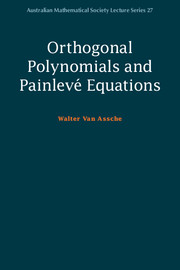Book contents
- Frontmatter
- Contents
- Preface
- 1 Introduction
- 2 Freud weights and discrete Painlevé I
- 3 Discrete Painlevé II
- 4 Ladder operators
- 5 Other semi-classical orthogonal polynomials
- 6 Special solutions of Painlevé equations
- 7 Asymptotic behavior of orthogonal polynomials near critical points
- Appendix Solutions to the exercises
- References
- Index
Preface
Published online by Cambridge University Press: 08 December 2017
- Frontmatter
- Contents
- Preface
- 1 Introduction
- 2 Freud weights and discrete Painlevé I
- 3 Discrete Painlevé II
- 4 Ladder operators
- 5 Other semi-classical orthogonal polynomials
- 6 Special solutions of Painlevé equations
- 7 Asymptotic behavior of orthogonal polynomials near critical points
- Appendix Solutions to the exercises
- References
- Index
Summary
These notes are intended to explain the relationship between orthogonal polynomials and Painlevé equations. They are not intended to give a systematic theory of Painlevé equations, their transformations and classification. This can be found elsewhere; we recommend in particular the classical book by Ince [88, §14.4], the more recent books [46, 68, 82, 125] and the review papers [80] and [96] on discrete and continuous Painlevé equations. Researchers in orthogonal polynomials will find the notes useful to see how semi-classical orthogonal polynomials often lead to discrete and continuous Painlevé equations. Usually only special solutions of these Painlevé equations in terms of classical special functions will be relevant. Furthermore, some integrable systems, such as the Toda lattice and related differential-difference systems, also appear in a very natural way in the theory of orthogonal polynomials. Those interested in the asymptotic behavior of orthogonal polynomials may appreciate seeing that Painlevé transcendents are used for the local analysis near critical points. Researchers in integrable systems, and in particular in Painlevé equations, may find it useful to see that a lot of explicit systems of orthogonal polynomials are described using discrete and continuous Painlevé equations. These applications in orthogonal polynomial theory often give a new viewpoint of Painlevé equations, in particular on the behavior of the special solutions of these equations.
Acknowledgments
I started writing these notes for a master course that I taught at the Universidad Carlos III de Madrid in May 2012. That course essentially consisted of Chapters 1–3. I continued these notes during my sabbatical trip to the University of Sydney in August 2016, where I started Chapters 4 and 6–7. I finally finished the notes at the African Institute for Mathematics in Cameroon in March–April 2017. I would like to thank the people in Leganés (Madrid), Sydney and AIMS Cameroon for their hospitality and for the discussions which I had on the topics of these notes. I am also grateful to the referee for pointing out many papers that are relevant for these lecture notes.
- Type
- Chapter
- Information
- Orthogonal Polynomials and Painlevé Equations , pp. xi - xiiPublisher: Cambridge University PressPrint publication year: 2017

